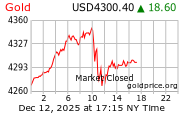The Gold Price ticked higher Monday morning in London, rising back through $1050 an ounce as world stock markets jumped and the Euro gained vs. the Dollar.
Government bonds also rose, as did crude oil, base metals and soft commodities.
London's AM Gold Fix was set 4.7% above last Monday's start at $1052 an ounce, while Eurozone investors now Ready to Buy Gold saw the price stand 4.0% better at a new 7-month high of 714 euro an ounce.
Gold priced in Sterling stood more than 6.1% above its level of last Monday morning, trading almost one-fifth higher at 666 pound an ounce from the mid-summer low.
'Today could be quiet,' says one London dealer in a note, 'as the US is on holiday and volumes low.'
'A short consolidation at this level would create a strong base for the next leg higher though,' says another.
'We do remain concerned that gold as an 'inflation trade' is both expensive and premature,' says a research note from J.P.Morgan in New York, 'but the flows speak for themselves.
'Gold has been the overwhelming beneficiary of investment allocations to commodities all year,' the former investment bank says, setting price targets of $1,000 an ounce between now and end-Dec., with a rise to $1,100 looking 'likely' for early 2010.
Last week saw betting on Gold Futures and options swell by 10% to a 15-month record of 635,000 contracts.
The 'net long' position held by hedge funds and other speculative players - meaning the number of bullish bets minus bearish contracts - rose to a fresh record of 259,000.
On the other side of this leveraged, derivative market, the 'net short' position held by commercial players such as miners, refineries and bullion banks hit a near record of 304,000 contracts.
'Other than being nice to have, the case for investing in gold looks to me like another example of the greater fool theory,' writes Anthony Hilton in the Evening Standard.
'[Gold] makes sense just as long as there is someone out there willing to pay even more for the metal than you did.'
'Gold's usefulness as an inflation hedge has been exaggerated,' agrees David Smith of London's Sunday Times - also judging gold's performance from the one-day spike of $850 an ounce, hit on 21st Jan. 1980.
'With many countries suffering deflation, inflation worries look misplaced.'
'Let's remember that the US bond market is many multiples bigger than the gold market,' says fixed-income strategist George Goncalves at broker Cantor Fitzgerald.
'As a bond analyst my money is on the bond market being right about inflation. There is no inflation now or in the near-term.'
'Gold is a volatile, high-risk asset that pays no income,' says Jeff Salway in The Scotsman, 'while the current high means investors have almost certainly missed out on the biggest price jumps.'
'Our target of $1,100 for gold in Q4:09 stands,' counters Walter de Wet at South Africa's Standard Bank here in London.
'While we see few inflationary pressures in large developed markets, this should not affect the Gold Price negatively. We believe Q4 seasonal jewelry demand, less scrap coming to the market (relative to previous periods when gold traded above $1,000) and investment demand...should see gold trade higher at the same Dollar/Euro exchange rate.'
Standard Bank's analysts expect the US Dollar to continue falling vs. the European single currency between now and March, dropping from $1.48 per Euro to $1.58 or worse.
'There's been talk about [Gold at] $1500, and I see that as perfectly achievable,' said Arthur Hood, CEO of Australia's second-biggest gold miner, Lihir Gold, in an interview this weekend.
'There's been a constant upward trend and we're not surprised by this at all. On the supply and demand side, there's gently declining mine supply but physical demand for gold is staying constant or actually increasing.'



No comments:
Post a Comment